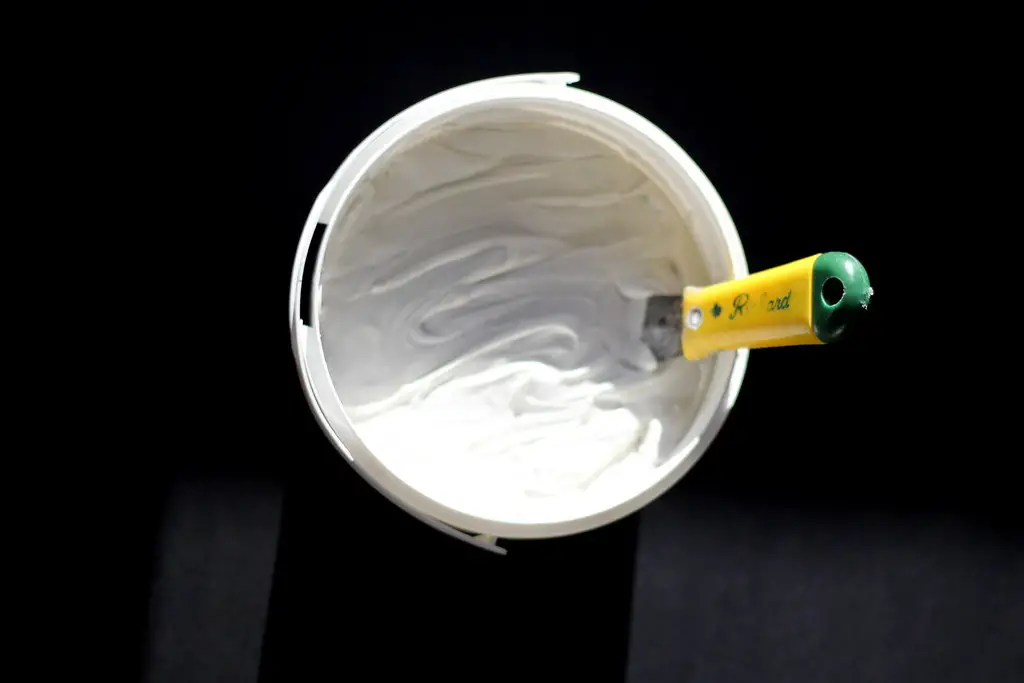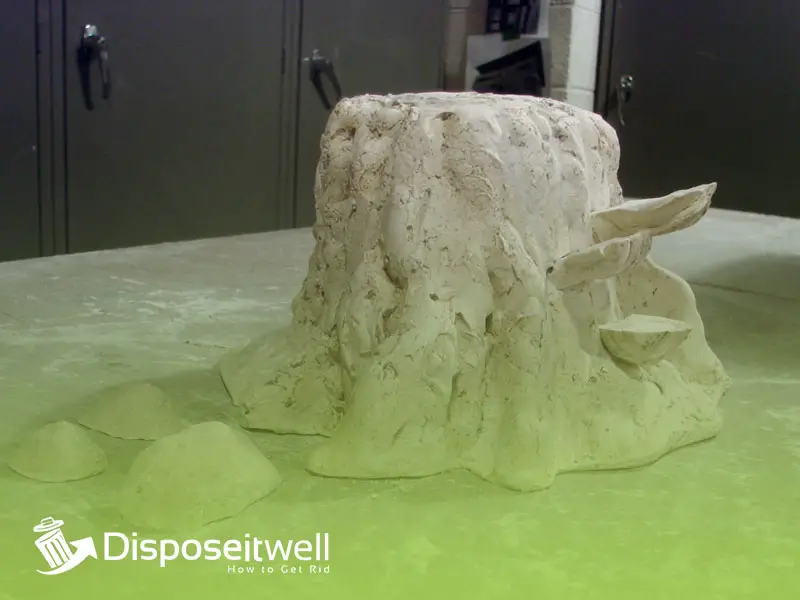Though frequently used, most people do not know how to dispose of Plaster. Unlike other building materials, getting rid of plaster and its components is not easy. One of the best methods to get rid of old stuff is recycling it, which helps keep the environment safe. In cases like this, it’s best to recycle the extra plaster or send it back to the manufacturer or supplier.
Plasterboard should be recyclable or easily disposed of at most municipal landfills or recycling centers. Find out ahead of time which local establishments provide this option. If possible, use a recycling alternative. This article discusses the various ways how to dispose of Plaster.
Is Plaster Dangerous?
Inhaling airborne plaster dust during the wet-to-dry mixing process and sanding down dried materials poses a significant risk. This is due to the composite nature of plastering materials, which include elements like calcium sulphate hemihydrate, limestone, clays, traces of silica and mica, and hydrated lime.
Breathing in the dust from these substances can cause short- and long-term health problems, especially for the lungs. Exposure to asbestos can be triggered by contact with ACMs or by their accidental disturbance. Inhaling dust from sanding plaster materials is a leading cause of chronic obstructive pulmonary disease (COPD) and occupational asthma, both potentially fatal lung diseases.
Can we recycle the Plaster of Paris?
Plaster of Paris can be recycled by drying it until it becomes powder. The Plaster can then be re-blended with water and used to make new molds of virtually any design.
Plaster Dehydration
Preheat your oven and bake the plaster at 180 C (356 F). The Plaster will become hot enough for all the water to evaporate. Take the Plaster of Paris piece outside, cover it with an old cloth, and the mess will disappear. Protect your lungs and eyes from dust by donning a face mask and a pair of safety goggles.
Set the mold on a stable surface, such as a workbench, in a metal or plastic tray. Use a hammer to smash the mold into small fragments. (Wear safety glasses and take other precautions while doing this.) Put them on a disposable oven pan, like the kind you’d use for a turkey or a roast. Dust may be removed from towels by washing them in the machine.
Preheat the oven and place the oven pan inside. Give the bits of Plaster a night to dry out. If you don’t feel safe leaving the oven on all night, you can get the procedure started in the morning and remove the Plaster before bed. The water in the Plaster will progressively evaporate due to the high temperature in the oven.
The next morning, remove a single plaster slab from the oven.
To determine if there is any lingering moisture, crush it with a hammer. It could take many more hours for the Plaster to dry out completely. If it is dry enough, it can be broken into a fine powder. Remove the remaining plaster pieces from the oven and let them cool fully.
Put the pieces in a grinder and process them until they resemble a powder. Plaster of Paris is recyclable and can be put to good use elsewhere. All you have to do is add more water and stir to change the form.
Is Plaster Biodegradable?
There is insufficient evidence to determine whether Plaster of Paris is biodegradable. People have argued that the results vary depending on the components and the processing methods used on the Plaster of Paris. Materials including plastic, glass, and paper are commonly used in the production of Plaster of Paris.
When mixed, these compounds can speed up biodegradation. Some of the components of Plaster of Paris, such as the plastic and glass ones, may be biodegradable, while the paper ones are not. Paper’s ability to form biodegradable composites with other materials sets it apart from nonbiodegradable plastics and glasses.
How to Dispose of Plaster?

1- Decorative Ceiling Patterns
Plasterboards are simple to cut and install if you have the right tools. So, if you have a few unused plasterboards, use them to your advantage and make some lovely ceiling patterns.
2- Give it Away
Some people have a pressing need for plasterboards but lack the financial resources to purchase any. You can check with neighborhood builders to determine if they need more components. You can also post it for free on social media sites or classified ads websites like Facebook or Craigslist. Many individuals could use some kindness right now.
3- Plasterboard Storage Racks
Making shelves or racks is another inventive technique to reuse old plasterboard. It’s possible to construct a shelf out of them, perfect for keeping books and other necessities. Before beginning, it is essential to put the design on paper and double-check your measurements. You can make shelves in various sizes, styles, and configurations with the help of internet guides.
4- Plasterboard Bar Counter
Plasterboard is versatile, and you may shape it into a bar counter and decorate it however you choose. Remember that you’ll need to install some shallow shelves inside the main counter to store beverages. The versatility of a plasterboard bar counter makes it a fantastic choice for use in any room.
5- Plasterboard Arches
Elegant arches are often found at the entryways of luxury residences. You may do the same thing in your home by installing arched doors between rooms.
6- Plasterboard Partitions
Partitions are necessary if you want to separate a large room in your house into smaller, more manageable areas. Plasterboard walls can serve as room dividers and displays for prized possessions.
Precautions to Take Before Disposing of Plaster
Plasterboard waste should be disposed of independently through a dedicated waste disposal service or a recycling operation.
Gypsum, one of the ingredients in plasterboard, is not technically a hazardous waste but can cause issues if not disposed of properly. Hydrogen sulphide gas, which is smelly and toxic, is produced when gypsum is combined with biodegradable wastes like manure and sewage.
Gypsum-based materials must be buried in landfill cells that do not permit the disposal of biodegradable trash. Plasterboard can also have gypsum extracted from it so that the remaining materials can be reused.
Additionally, the plasterboard should not be burned. This material is generally safe to use and dispose of, but improper handling can cause it to release toxic gases that can harm people and the environment.
Is Plaster the Same as Drywall?
Plaster and drywall are two common forms of interior wall materials. However, these two are vastly distinct from one another. Below are the common differences between plaster and drywall;
Plaster Is More Expensive than Drywall
Plastering a room requires more time and expertise than drywalling. This means the labor costs will be at least three times as high. In terms of raw materials, the prices are roughly the same.
Techniques in Building Construction
Plastering walls traditionally involves covering the framing studs with wood lath. Plaster is first applied as a base coat to fill in the cracks, and another layer, or two, is applied on top to smooth things out. The traditional wood lath backing has been replaced with a metal mesh backing. The application method is identical and very similar to that of applying stucco to exterior walls.
Drywall is available in massive sheets of compressed gypsum covered in paper. You can attach it with nails or screws, but screws are preferred. To make a seamless surface, you will need to apply a joint compound to the seams. It takes much less time and compounds than a traditional plaster wall.
Plaster Provides a More Refined Appearance
Plaster can be finished with a smooth, glossy appearance or a textured stucco-like appearance. Although drywall has become the norm in most homes, plaster is still used for several decorative purposes.
Plaster is More Soundproof
Plaster, being a dense material, is superior to gypsum drywall in its ability to dampen noise. Plaster may be denser, but it can’t compete with the thermal efficiency of today’s standard drywall and insulation. Drywall installation provides the versatility to work with multiple layers.
Difference between Gyprock and Plasterboard
Various names, including gyprock, drywall, gypsum board, wallboard, sheetrock, and others, are used to refer to plasterboard, a building material that is widely used around the world. Plaster has been used for thousands of years to coat walls and ceilings with a smooth internal finish. Plaster is created from lime, sand, animal hair, and other components.
The name “Gyprock” stems from the discovery that gypsum-based plasters had a faster drying time than lime-based plasters when applied wet. These plasters were used in the production of plasterboards. Plasterboard is made by pressing a thin layer of gypsum plaster between two thick sheets of specialty paper. It is possible to make gyprock sheets with soundproofing or water-resistant features by altering the technique and the materials used.
FAQs
Can You Pour Plaster Down the Sink?
The adhesive and hardened substance might accumulate in your plumbing system if you flush Plaster down the toilet. At first, this may only slow drains down a little amount. However, with time, Plaster can accumulate to the point where it totally obstructs the drain.
Can Plaster be Composted?
It is possible to provide a supply of calcium for the soil by breaking down leftovers of plaster and old molds and incorporating them into compost.
Verdict
Plasterboard can be used in many different ways. Despite the fact that just a fraction of the population knows about the damage it does to the planet. You should have no issue at all now that you know about the consequences to the environment and how to properly recycle and upcycle plasterboard.
It’s critical to be aware that plasterboard is not biodegradable because it is a widely used product that cannot be broken down by microbes. It’s true that plasterboard and drywall aren’t exactly the same, but they can be used in place of one another in many situations.
My name is Ella Vicedomine and I’m the founder of this blog. The aim is to start this informational blog to guide people on how to dispose of waste things around in the house but in the right way.

